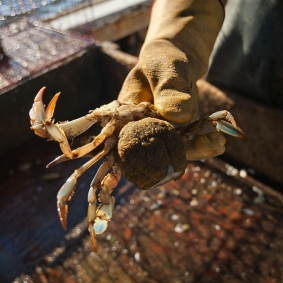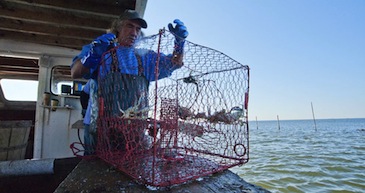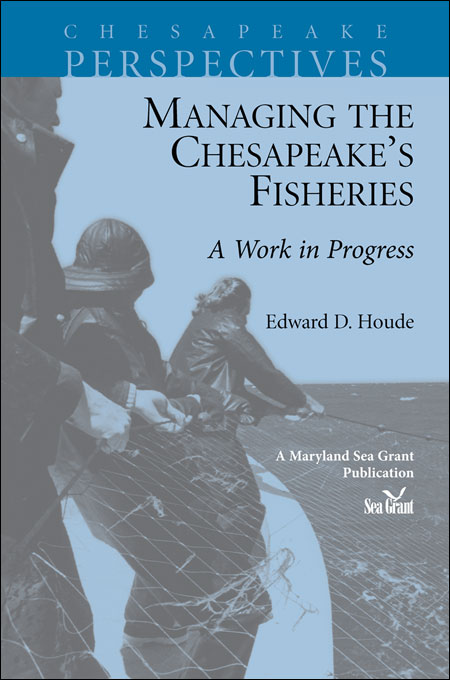Knauss legislative fellowships in Congress help build careers — and they're fun and educational. See our video and fact sheet for details.
Tighter Rules Could Increase Yield and Revenues From Blue Crabs, Study Finds

Findings Support Further Shortening the Fishing Season
The Chesapeake Bay’s blue crab fishery could support a larger harvest and higher revenues for watermen if regulators extended protections for mature female crabs, a new study says.
The analysis, funded by Maryland Sea Grant, reflects evolving thinking among scholars that economics can help inform decisions about how to manage fisheries sustainably. As a pilot study, the researchers created a computer model to simulate and compare the effects of actual and proposed fishing rules on yield and sales revenue from the Chesapeake’s blue crab fishery. Regulators in Maryland and Virginia have tried to craft the rules -- like limits on crab size and season duration -- to ensure sustainable harvest levels, ones that leave enough crabs in the Bay to reproduce and maintain the population.
The researchers used their model to examine whether altering particular policies, like shortening the season, would tend to increase or decrease the sustainable yield and revenue earned by commercial watermen. The researchers compared the effects of modifying different policies.
The blue crab fishery is one of Maryland’s most lucrative, providing 50 percent of all blue crabs harvested in the United States. Three jurisdictions regulate blue crab fishing in the Bay – the states of Maryland and Virginia and the Potomac River Fisheries Commission – and in recent years they have adjusted harvest limits to promote sustainability.
In 2008 Maryland shortened the fall crabbing season and Virginia outlawed the dredging of crabs – all females – that bury themselves in mud in the southern Bay in winter. Those moves were intended to allow enough adult females to survive and reproduce. And those changes were credited for a boom in the estimated crab population in 2011. However, the population plummeted in 2012 and 2013 for reasons that remain unclear, possibly involving environmental factors separate from fishing pressure. For now, the tighter regulations have remained in place even as watermen have called for loosening them.
The findings from the Maryland Sea Grant-funded study supported offering additional protections for female crabs – shortening even further the harvest season and instituting maximum size limits for adult females. Out of the many policy changes studied, those were among only a few significantly correlated with increases in both sustainable yield and revenues. “A small set of policies are most critical – other policies might be relaxed or, at least, held constant over time,” the researchers wrote about their findings.
There are currently no size restrictions for mature females, maximum or minimum. The analysis indicated that instituting restrictive minimum size limits would likely not increase yield or revenue.
 |
| Harvesting blue crabs on the Chesapeake. Credit: Michael Fincham |
The study’s design carried certain limitations that affect the findings, notes Michael Wilberg, a coauthor of the study. He is a fisheries scientist at the Chesapeake Biological Laboratory of the University of Maryland Center for Environmental Science. The model does not show the effect of year-to-year swings in the crab population on revenues and yield. Also, the authors were not able to estimate effects of policy changes on watermen’s profits. Different policies may have different effects on watermen’s costs and hence profits, but the authors lacked data to estimate costs. In addition, the findings do not address whether certain regulatory changes raise issues of fairness by affecting some watermen more than others.
Even with those limitations, "We're offering an additional set of considerations that weren't out there before when people are choosing what policies they want to adopt to manage the fishery,” Wilberg says.
 |
| Michael Wilberg. Credit: Chesapeake Biological Laboratory |
The research team also included Pei Huang, a doctoral student, and Richard Woodward, an economist, both at Texas A&M University; and David Tomberlin, an economist at the National Oceanic and Atmospheric Administration.
The researchers presented their findings in 2013 to regulators and others who serve on a sustainable-fishing committee of the Chesapeake Bay Program, a federal-state effort that works to restore the Bay. The project was intended as a demonstration of an analytical framework and its potential use in fisheries management. Methods developed in the study will be used in the next scientific stock assessment for the blue crab fishery. These assessments provide information on the population dynamics that inform fishing regulations.
The study was based on data collected from 1994 to 2010 about harvest quantities and prices for crabs of different ages, sexes, and types, including soft crabs (peelers). The model estimated sustainable yields could range widely, from as few as 160 million to about 450 million crabs a year, depending on which fishing rules were applied.
-- Jeffrey Brainard
Photo (top left): A sponge crab, or female laden with eggs. Credit: Michael Fincham
Learn more
"Tracking the Blue Crab Comeback," Chesapeake Quarterly, Maryland Sea Grant's magazine. This package of articles describes fishing techniques as well as scientific studies that examined possible environmental causes of the large fluctuations in the Bay's population of blue crabs.
Read about another economic analysis of the blue crab fishery that informed a Maryland program to buy back crab fishing licenses.






